…Hornby Gauge 0
Meccano Limited of Liverpool, England, was famous for its metal construction sets of the same name. Designed by Frank Hornby and introduced in the year 1901, the ingenious combination of perforated metal strips, angles, wheels, gears, nuts and bolts allowed Edwardian boys to recreate the industrial world around them in miniature. More than a few of them would have grown up to be engineers, no doubt.

This 0-4-0 clockwork engine is the one that started the
tinplate collection. It dates from 1927.
After World War I, toys were very low down on the list of priorities as the economy recovered. Patriotism was rampant and any ‘Foreign’ goods were frowned upon. The relationships that had blossomed before the war between manufacturers in Germany and Great Britain were no more. A huge gap was left in the market, and Mr Hornby had a brilliant idea.
Authentic railway atmosphere… what could be better?
He decided to expand the product range to include trains. At first, they were simple clockwork powered toys, but they soon were refined, until everything one could dream of to create a railway empire was available. The amalgamation of the many private railways into the ‘Big Four’ in 1921 offered the opportunity to produce the same shapes in four different liveries, namely the Southern, Great Western, London North East Railway and the London, Midland & Scottish Railway, or LMS for short.
-oOo-
Liverpool was LMS country, thus it should be no surprise, that crimson is the most common livery, closely followed by the LNER’s handsome apple green locomotives and teak coaches. Less attention was paid to the other, far away railways, which makes a GW or Southern livery much rarer today.
This electric NORD Riviera Blue Train set, based on the famous
French prototype dates from the mid-1930s.
The Hornby Trains were made entirely of metal, beautifully lithographed or enamelled. The shapes were simple representations of real trains, held together initially by Meccano nuts and bolts. Though the carriages could be taken apart, there was only one way they could be put back together!

The picture on the box of this typical post-war Hornby train set
promises more than its contents can deliver.
The pinnacle was reached in the late 1930s. After World War II, there was not the space available in tiny post-war homes, to accommodate even a moderate Gauge 0 layout, and the large trains fell out of favour. The range lived on into the British Railways era, to finally succumb in the 1960s.
…Related Pages







